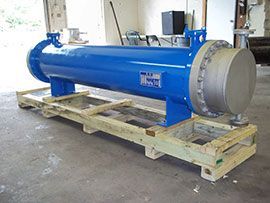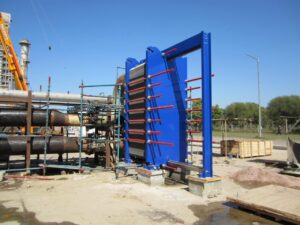Heat exchangers are devices that enable the transfer of heat between two or more fluids. From the generation of electricity to the processing of food, they are essential to many industries. The effective operation of these industries often depends on the proper use of heat exchangers. In this blog, we’ll explain the different types of heat exchangers, their functions, and their industrial applications.
What Are Heat Exchangers?
A heat exchanger is a device that transfers heat from one substance to another. These substances can be either gases or liquids. Heat exchangers are designed to transport heat as efficiently as possible while consuming the least amount of energy. Typically, the fluids do not mix and are kept separate by a solid barrier, such as metal.
Why Are Heat Exchangers Essential in Industries?
Temperature control is a key factor in many industrial processes. Heat exchangers help regulate temperatures, ensuring equipment operates safely and efficiently. They prevent machinery from overheating, which enhances productivity and lowers energy costs. Without heat exchangers, many industrial processes would face significant challenges or become inefficient.
Different Types of Heat Exchangers
There are several types of heat exchangers, each designed to meet specific industrial needs. Below, we explore the most common types used in various industries.
1. Shell and Tube Heat Exchangers
Shell and tube heat exchangers are widely used in industrial settings. They consist of multiple tubes placed inside a larger cylindrical shell. One fluid flows through the tubes while another fluid flows around them inside the shell. This design is durable and can handle high temperatures and pressures. These heat exchangers are often found in oil refineries, chemical plants, and power generation facilities.

2. Plate Heat Exchangers
Plate heat exchangers transfer heat between fluids using thin, corrugated metal plates. The plates are stacked with narrow gaps between them, allowing fluids to flow in alternating layers. This design is more compact and efficient compared to shell and tube heat exchangers. Plate heat exchangers are commonly used in industries such as food processing, heating, ventilation, air conditioning (HVAC), and refrigeration.

3. Air-Cooled Heat Exchangers
Air-cooled heat exchangers use air to cool a fluid rather than relying on water. These systems are ideal in locations where water is scarce or expensive. In air-cooled heat exchangers, the fluid circulates through a series of tubes, with fans blowing air across the tubes to cool the fluid. These exchangers are frequently used in power plants, oil and gas facilities, and chemical plants, where they provide energy-efficient cooling with low maintenance requirements.
4. Double Pipe Heat Exchangers
Double pipe heat exchangers are a simpler form of heat exchanger that contains one pipe within another. When two fluids flow, one passes through the inner pipe and the other between the two. This type of heat exchanger is often used in smaller industries where the demand for heat transfer is lower. Although less efficient than other types, double-pipe heat exchangers are cost-effective and easy to maintain, making them suitable for specific applications.
5. Plate and Frame Heat Exchangers
Plate and frame heat exchangers are similar to plate heat exchangers but are assembled within a frame that holds the plates together. The plates can be easily removed for cleaning and maintenance, making this type versatile and efficient. Plate and frame heat exchangers are often used in the dairy, pharmaceutical, and chemical industries, where they can handle varying pressures and temperatures.
6. Fin Tube Heat Exchangers
Fin tube heat exchangers were designed to maximize the available surface area for heat transmission. Thin metal fins are attached to the tubes, which improves the efficiency of heat transfer. These exchangers are commonly used in air conditioning systems, automotive radiators, and power plants. The added fins help to dissipate heat more effectively, making these exchangers ideal for cooling applications.
Selecting the Right Heat Exchanger
Choosing the appropriate heat exchanger depends on several factors. You must consider the type of fluids, temperature ranges, pressure conditions, and the desired rate of heat transfer. Additionally, the available space and budget constraints influence the decision. Selecting the right type of heat exchanger ensures optimal performance and longevity in industrial applications.
Applications in Various Industries
Heat exchangers are vital in multiple industries, each with specific needs:
- Oil and Gas Industry: Used for temperature control during refining and processing.
- Power Generation: Essential for cooling turbines and other components.
- Chemical Processing: Utilized in reactors, distillation columns, and other processes.
- HVAC Systems: Important for regulating building temperatures.
- Food and Beverage Industry: Employed in processes like pasteurization and sterilization.
Conclusion
Heat exchangers are indispensable in many industrial applications. Understanding the different types and their specific uses can help industries operate more efficiently. Whether it’s for large-scale power generation or small-scale food processing, the right heat exchanger ensures that processes run smoothly, safely, and cost-effectively.
If you’re looking for high-quality heat exchangers that are reliable, and deliver exceptional performance, look no further than Pragya Associates. Get in touch with us today to learn about our products and services. We’re excited to help you achieve your goals.




